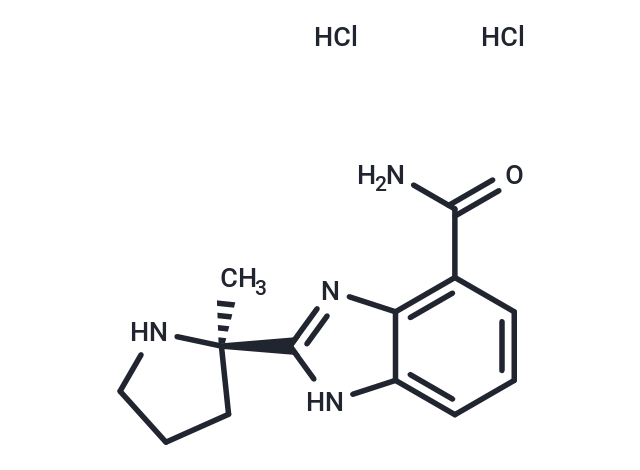Shopping Cart
- Remove All
 Your shopping cart is currently empty
Your shopping cart is currently empty

Veliparib dihydrochloride (ABT-888 dihydrochloride) is a potent inhibitor of PARP1 and PARP2 with Ki of 5.2 nM and 2.9 nM in cell-free assays, respectively. It is inactive to SIRT2.

| Pack Size | Price | Availability | Quantity |
|---|---|---|---|
| 5 mg | $30 | In Stock | |
| 10 mg | $40 | In Stock | |
| 25 mg | $71 | In Stock | |
| 50 mg | $118 | In Stock | |
| 100 mg | $190 | In Stock | |
| 200 mg | $310 | In Stock | |
| 1 mL x 10 mM (in DMSO) | $31 | In Stock |
| Description | Veliparib dihydrochloride (ABT-888 dihydrochloride) is a potent inhibitor of PARP1 and PARP2 with Ki of 5.2 nM and 2.9 nM in cell-free assays, respectively. It is inactive to SIRT2. |
| Targets&IC50 | PARP2:2.9 nM(Ki), PARP1:5.2 nM (Ki) |
| In vitro | Veliparib demonstrates inactivity towards SIRT2 at concentrations greater than 5 μM[1] and exhibits potent inhibition of PARP activity, with an EC50 of 2 nM in C41 cells[2]. It effectively reduces PAR levels in H460 cells, regardless of irradiation status, and significantly impairs clonogenic survival by hindering DNA repair via PARP-1 inhibition. Additionally, when used in conjunction with radiation, Veliparib promotes apoptosis and autophagy in H460 cells[3]. Its ability to inhibit PARP activity extends to H1299, DU145, and 22RV1 cells, a process not influenced by p53 function. At a concentration of 10 μM, Veliparib diminishes the surviving fraction in clonogenic H1299 cells by 43%, enhancing radiosensitivity, particularly in oxygen-rich environments. Furthermore, it reduces the surviving fraction in H1299, DU145, and 22RV1 cells under hypoxic-irradiated conditions[4], confirming its role in sensitizing cancer cells to radiation by targeting PARP-dependent mechanisms. |
| In vivo | Veliparib exhibits an oral bioavailability ranging from 56% to 92% across different species, including mice, SD rats, beagle dogs, and cynomolgus monkeys[1]. At a dosage of 25 mg/kg (i.p.), it enhances tumor growth delay in NCI-H460 xenograft models and, when combined with radiation, decreases tumor vessel formation[3]. Additionally, Veliparib significantly reduces intratumor PAR levels by over 95% at dosages of 3 and 12.5 mg/kg in A375 and Colo829 xenograft models, with this suppression sustained over time[4]. |
| Kinase Assay | PARP assays are conducted in a buffer containing 50 mM Tris (pH 8.0), 1 mM DTT, 1.5 μM [3H]NAD+?(1.6 μCi/mmol), 200 nM biotinylated histone H1, 200 nM slDNA, and 1 nM PARP-1 or 4 nM PARP-2 enzyme. Reactions are terminated with 1.5 mM benzamide, transferred to streptavidin Flash plates, and counted using a TopCount microplate scintillation counter. |
| Alias | ABT-888 dihydrochloride |
| Molecular Weight | 317.21 |
| Formula | C13H18Cl2N4O |
| Cas No. | 912445-05-7 |
| Smiles | Cl.Cl.C[C@@]1(CCCN1)c1nc2c(cccc2[nH]1)C(N)=O |
| Relative Density. | no data available |
| Storage | Powder: -20°C for 3 years | In solvent: -80°C for 1 year | Shipping with blue ice. | ||||||||||||||||||||||||||||||||||||||||
| Solubility Information | DMSO: 3.2 mg/mL (10.09 mM), Sonication is recommended. H2O: 50 mg/mL (157.62 mM), Sonication is recommended. | ||||||||||||||||||||||||||||||||||||||||
Solution Preparation Table | |||||||||||||||||||||||||||||||||||||||||
DMSO/H2O
H2O
| |||||||||||||||||||||||||||||||||||||||||

Copyright © 2015-2025 TargetMol Chemicals Inc. All Rights Reserved.